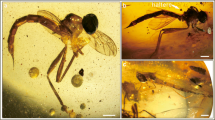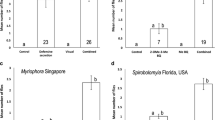Abstract
Pyrrolizidine alkaloids (PAs) are defensive secondary metabolites found in numerous plant groups. Various insects belonging to different orders have special requirements for these compounds and sequester them from such plants for their own defense and often as pheromone precursors. The fitness of these insects depends on PAs and, in some cases, PAs even act as regulators of androconial organ development. This article discusses selected behavioral, chemical, physiological, and phylogenetic aspects of insect-PA relationships, and raises questions about the complex interactions of the variety of PA-related adaptations as they occur among a diverse array of species. Although many superficial similarities are recognized, few generalizations can yet be drawn. However, insect-PA relationships not only exemplify basic features of chemical ecology but illustrate a multiplicity of aspects and adaptations, which we should expect to find in any thorough study of insect-plant relationship.
Similar content being viewed by others
References
Ackery, P.R., andVane-Wright, R.I. 1984. Milkweed Butterflies—Their Cladistics and Biology. British Museum (Natural History), London.
Aplin, R.T., andRothschild, M. 1968. Poisonous alkaloids in the body tissues of the cinnabar moth (Callimorpha jacobaeae L.).Nature 219:747–748.
Aplin, R.T., andRothschild, M. 1972. Poisonous alkaloids in the body tissues of the garden tiger moth (Arctia caja L.) and the cinnabar moth [Tyria (=Callimorpha) jacobaeae L.] (Lepidoptera), pp. 579–595,in A. de Vries and K. Kochva (eds.). Toxins of Animal and Plant Origin. Gordon & Breach, London.
Aplin, R.T., Benn, M.H., andRothschild, M. 1968. Poisonous alkaloids in the body tissues of the cinnabar mothI (Callimorphajacobaeae L.).Nature 219:747–748.
Bell, T.W., andMeinwald, J. 1986. Pheromones of two arctiid moths (Creatonotos transferts andC. gangis); chiral components from both sexes and achiral female components.J. Chem. Ecol. 12:385–409.
Bell, T.W., Boppré M., Schneider, D., andMeinwald, J. 1984. Stereochemical course of pheromone biosynthesis in an arctiid moth (Creatonotos transiens).Experientia 40:713–714.
Benn, M., Degrave, J., Gnanasunderam, C., andHutchins, R. 1979. Host-plant pyrrolizidine alkaloids inNyctemera annulate Boisduval: Their persistance through the life-cycle and transfer to a parasite.Experientia 35:731–732.
Bentley, M.D., Leonard, D.E., Stoddard, W.F., andZalkow, L.H. 1984. Pyrrolizidine alkaloids as larval feeding deterrents for spruce budworm,Choristoneura fiimiferana (Lepidoptera: Tortricidae).Ann. Entomol. Soc. Am. 77:393–397.
Bernays, E.A., andChapman, R.F. 1977. Deterrent chemicals as a basis of oligophagymLocusta migratoria.Ecol. Entomol. 2:1–18.
Bernays, E.A., Edgar, I.A., andRothschild, M. 1977. Pyrrolizidine alkaloids sequestered and stored by the aposematic grasshopperZonocerus variegatus.J. Zool. (London) 182:85–87.
Blum, M.S. 1981. Chemical Defenses of Arthropods. Academic Press, New York.
Bogner, F., andBoppré, M. 1989. Single cell recordings reveal hydroxydanaidal as the volatile compound attracting insects to pyrrolizidine alkaloids.Entomol. Exp. Appl. 50:171–184.
Boppré, M. 1981. Adult Lepidoptera “feeding” at witheredHeliotropium plants (Boraginaceae) in East Africa.Ecol. Entomol. 6:449–452.
Boppré, M. 1983. Leaf-scratching—a specialized behavior of danaine butterflies (Lepidoptera) for gathering secondary plant substances.Oecologia (Berlin) 59:414–416.
Boppré, M. 1984a. Chemically mediated interactions between butterflies.Symp. R. Entomol. Soc. London 11:259–275 (=The Biology of Butterflies, R.I. Vane-Wright and P.R. Ackery (eds.). Academic Press, London).
Boppré, M. 1984b. Redefining “pharmacophagy.”J. Chem. Ecol. 10:1151–1154.
Boppré, M. 1986. Insects pharmacophagously utilizing defensive plant chemicals (pyrrolizidine alkaloids).Naturwissenschaften 73:17–26.
Boppré, M., andPitkin, B.P. 1988. Attraction of chloropid flies to pyrrolizidine alkaloids (Diptera: Chloropidae).Entomol. Gener. 13:81–85.
Boppré, M., andSchneider, D. 1985. Pyrrolizidine alkaloids quantitatively regulate both scent organ morphogenesis and pheromone biosynthesis in maleCreatonotos moths (Lepidoptera: Arctiidae).J. Comp. Physiol. 157:569–577.
Boppré, M., andSchneider, D. 1989. On the biology ofCreatonotos (Lep.: Arctiidae) with special reference to the androconial system.Zool. J. Linn. Soc. 96:339–356.
Boppré, M., Petty, R.L., Schneider, D., andMeinwald, J. 1978. Behaviorally mediated contacts between scent organs: another prerequisite for pheromone production inDanaus chrysippus males (Lepidoptera).J. Comp. Physiol. 126:97–103.
Boppré, M., Seiet, U., andWickler, W. 1984. Pharmacophagy in grasshoppers?Zonocerus being attracted to and ingesting pure pyrrolizidine alkaloids.Entomol. Exp. Appl. 35:115–117.
Borden J.H. 1985. Aggregation pheromones, pp. 257–285,in G.A. Kerkut and L.I. Gilbert (eds.). Comprehensive Insect Physiology, Biochemistry and Pharmacology 9. Pergamon Press, Oxford.
Brower, L.P. 1969. Ecological chemistry.Sci. Am. 220(2):22–29.
Brower, L.P. 1984. Chemical defence in butterflies.Symp. R. Entomol. Soc. London 11:109–134 (=The Biology of Butterflies, R.I. Vane-Wright and P.R. Ackery (eds.)). Academic Press, London.
Brown, K.S. 1984a. Adult-obtained pyrrolizidine alkaloids defend ithomiine butterflies against a spider predator.Nature 309:707–709.
Brown, K.S. 1984b. Chemical ecology of dehydropyrrolizine alkaloids in adult Ithomiinae (Lepidoptera: Nymphalidae).Rev. Brasil. Biol. 44:435–460.
Brown, K.S. 1987. Chemistry at the Solanaceae/Ithomiinae interface.Ann, M. Bot. Gard. 74:359–397.
Bull, L.B., Culvenor, C.C.J., andDick, A.T. 1968. The Pyrrolizidine Alkaloids. North-Holland Publ., Amsterdam.
Conner, W.E., Eisner, T., Vandermeer, R.K., Guerrero, A., andMeinwald, J. 1981. Precopulatory sexual interaction in an archtiid moth (Utetheisa ornatrix): Role of a pheromone derived from dietary alkaloids.Behav. Ecol. Sociobiol. 9:227–235.
Conner, W.E.,Roach, B.,Benedict, E.,Meinwald, J., andEisner, T. 1989. Courtship pheromone production and body size as correlates of larval diet in males of the arctiid moth,Utetheisa ornatrix. J. Chem. Ecol. In press.
Culvenor, C.C.J., andEdgar, J.A. 1972. Dihydropyrrolizine secretions associated with coremata ofUtetheisa moths (family Arctiidae).Experientia 28:627–628.
Culvenor, C.C.J., Edgar, J.A., andSmith, L.W. 1981. Pyrrolizidine alkaloids in honey fromEchium plantagineum L.J. Agric. Food Chem. 29:958–960.
Devries, P.J., andStiles, F.G. 1989. Attraction of pyrrolizidine akaloids seeking Lepidoptera toEpidendrum paniculatum orchids and the potential effects of gene flow.Biotropica In press.
Deinzer, M.L., Thomson, P.A., Burgett, D.M., andIsaacson, D.L. 1977. Pyrrolizidine alkaloids: their occurrence in honey from tansy ragwort (Senecio jacobaea L.).Science 195:497–499.
Dussourd, D.E., Ubik, K., Harvis, K., Resch, J.F., Meinwald, J., andEisner, T. 1988. Biparental defensive endowment of eggs with acquired plant alkaloid in the mothUtethesia ornatrix.Proc. Natl. Acad. Sci. U.S.A. 85:5992–5996.
Edgar, J. A., Culvenor, C.C.J., andPliske, T.E. 1976. Isolation of a lactone, structurally related to the esterifying acids of pyrrolizidine alkaloid' from the costal fringes of male Ithomiinae.J. Chem. Ecol. 2:263–270.
Edgar, J.A., Culvenor, C.C.J., Cockrum, P.A., Smith, L.W., andRothschild, M. 1980. Callimorphine: identification and synthesis of the cinnabar moth “metabolite.”Tetrahedron Lett. 21:1383–1384.
Ehmke, A., Proksch, P., Witte, L., Hartmann, T., andIsman, M.B. 1989. Fate of ingested pyrrolizidine alkaloid A'-oxide in the grasshopperMelanoplus sanguinipes.Naturwissenschaften 76:27–29.
Eisner, T. 1980. Chemistry, defence, and survival: Case studies and selected topics, pp. 847–878,in M. Locke and D.S. Smith (eds.). Insect Biology in the Future. Academic Press, London.
Eisner, T. 1982. For love of nature: Exploration and discovery at biological field stations.Bio-Science 32:321–326.
Eisner, T., andMeinwald, J. 1987. Alkaloid-derived pheromones and sexual selection in Lepidoptera, pp. 251–269,in G.D. Prestwich and G.J. Blomquist (eds.). Pheromone Biochemistry. Academic Press, Orlando, Florida.
Goss, G.J. 1979. The interaction between moths and plants containing pyrrolizidine alkaloids.Environm. Entomol. 8:487–493.
Goss, G.J., andAdams, R.M. 1976. The reproductive biology of the epiphytic orchids of Florida IV. Sexually selective attraction of moths to the floral fragrance ofEpidendrum anceps Jacquin.Am. Orchid Soc. Bull. 45:997–1001.
Haber, W.A. 1978. Evolutionary Ecology of Tropical Mimetic Butterflies. PhD thesis. University of Minnesota.
Hartmann, T. 1985. Prinzipien des pflanzlichen Sekundärstoffwechsels.Plant Syst. Evol. 150:15–34.
Hartmann, T., andToppel, G. 1987. Senecionine N-oxide, the primary product of pyrrolizidine alkaloid biosynthesis in root cultures ofSenecio vulgaris.Phytochemistry 26:1639–1643.
Hartmann, T., Sander, H., Adolph, R., andToppel, G. 1988. Metabolic links between the biosynthesis of pyrrolizidine alkaloids and polyamines in root cultures ofSenecio vulgaris.Planta 175:82–90.
Johnson, A.E., andMolyneux, R.J. 1985. Variation in toxic pyrrolizidine alkaloid content of plants, associated with site, stage of growth and environmental conditions, pp. 209–218, in A.A. Seawright, M.P. Hegarty, L.F. James, and R.F. Keller (eds.). Plant Toxicology. Yeerongpilly, Australia.
Kelley, R.B., Seiber, J.N., Jones, A.D., Segall, H.J., andBrower, L.P. 1987. Pyrrolizidine alkaloids in overwintering monarch butterflies (Danaus plexippus) from Mexico.Experientia 43:943–946.
Krasnoff, S.B., andDussourd, D.E. 1989. Dihydropyrrolizine attractants for arctiid moths that visit plants containing pyrrolizidine alkaloids,J. Chem. Ecol. 15:47–60.
Krasnoff, S.B., andRoelofs, W.L. 1989. Quantitative and qualitative effects of larval diet on male scent secretions ofEstigmene acrea, Phragmatobia fuliginosa, andPyrrharctia Isabella (Lepidoptera: Arctiidae).J. Chem. Ecol. 15:1077–1093.
Krasnoff, S.B., Bjostad, L.B., andRoelofs, W.L. 1987. Quantitative and qualitative variation cin male pheromones ofPhragmatobia fuliginosa andPyrrharctia Isabella (Lepidoptera: Arctiidae).J. Chem. Ecol., 13:807–822.
L'empereur, K.M., Li, Y., Stermitz, F.R., andCrabtree, L. 1989. Pyrrolizidine alkaloids fromHackelia californien andGnophaela latipennis, andH. californica-hosted arctiid moth.J. Nat. Prod. 52:360–366.
Malcolm, S., andRothschild, M. 1983. A danaid Müllerian mimic,Euploea core amymone (Cramer) lacking cardenolides in the pupal and adult stages.Biol. J. Linn. Soc. 19:27–33.
Mattocks, A.R. 1986. Chemistry and Toxicology of Pyrrolizidine Alkaloids. Academic Press, London.
Molyneux, R.J., andJohnson, A.E. 1984. Extraordinary levels of production of pyrrolizidine alkaloids inSenecio riddellii.J. Nat. Prod. 47:1030–1032.
Mustaparta, H. 1984. Olfaction, pp. 37–70,in J.W. Bell and R.T. Cardé (eds.). Chemical Ecology of Insects. Chapman and Hall, London.
Pliske, T.E. 1975a. Attraction of Lepidoptera to plants containing pyrrolizidine alkaloids.Environm. Entomol. 4:455–473.
Pliske, T.E. 1975b. Pollination of pyrrolizidine alkaloid-containing plants by male Lepidoptera.Environm. Entomol. 4:475–479.
Pliske, T.E., Edgar, J.A., andCulvenor, C.C.J. 1976. The chemical basis of attraction of ithomiine butterflies to plants containing pyrrolizidine alkaloids.J. Chem. Ecol. 2:255–262.
Robins, D.J. 1982. The pyrrolizidine alkaloids.Progr. Chem. Nat. Prod. 41:115–203.
Rothschild, M. 1985. British aposematic Lepidoptera, pp. 9–62,in J. Heath (ed.). The Moth and Butterflies of Great Britain and Ireland, Vol. 2. Harley Books, Colchester, U.K.
Rothschild, M., van Euw, J., Aplin, R., andHarman, R.R.M. 1970. Toxic Lepidoptera.Taxicon 8:293–299.
Rothschild, M., Aplin, R.T., Cockrum, P.A., Edgar, J.A., Fairweather, P., andLees, R. 1979. Pyrrolizidine alkaloids in arctiid moths (Lep.) with a discussion on host plant relationships and the role of these secondary plant substances in the Arctiidae.Biol. J. Linn. Soc. 12:305–326.
Scherer, G., andBoppré, M. 1990. Attraction ofGabonia andNzerekorena (Chrysomelidae, Alticinae) to pyrrolizidine alkaloids—with descriptions of 13 new species and notes on male structural peculiarities.J. Nat. Hist. Submitted.
Schneider, D. 1987. The strange fate of pyrrolizidine alkaloids, pp. 123–143,in R.F. Chapman, E.A. Bernays, and J.G. Stoffolano (eds.). Perspectives in Chemoreception and Behavior. Springer Verlag, Heidelberg.
Schneider, D., Boppré, M., Zweig, J., Horsley, S.B., Bell, T.W., Meinwald, J., Hansen, K., andDiehl, E.W. 1982. Scent organ development inCreatonotos moths: Regulation by pyrrolizidine alkaloids.Science 215:1264–1265.
Schulz, S. 1987. Die Chemie der Duftorgane männlicher Lepidopteren. Dissertation, Fachbereich Chemie der Universität Hamburg.
Schulz, S., Francke, W., Edgar, J.A., andSchneider, D. 1988. Volatile compounds from androconial organs of danaine and ithomiine butterflies.Z. Naturforsch. 43c:99–104.
Smith, L.W., andCulvenor, C.C.J. 1980. Plant sources of hepatotoxic pyrrolizidine alkaloids.J. Nat. Prod. 44:129–152.
Toppel, G., Witte, L., andHartmann, T. 1988. N-Oxidation and degradation of pyrrolizidine alkaloids during germination ofCrotalaria scassellatii.Phytochemistry 27:3757–3760.
Wiedenfeld, H. 1982. Two pyrrolizidine alkaloids fromGynura scandens.Phytochemistry 21:2767–2768.
Wink, M., andSchneider, D. 1988. Carrier-mediated uptake of pyrrolizidine alkaloids in larvae of the aposematic and alkaloid-exploiting mothCreatonotos.Naturwissenschaften 75:524–525.
Wink, M., Schneider, D., andWitte, L. 1988. Biosynthesis of pyrrolizidine alkaloid-derived pheromones in the arctiid moth,Creatonotos transiens: Stereochemical conversion of heliotrine.Z. Naturforsch. 43c:737–741.
Wróbel, J.T. 1985. Pyrrolizidine alkaloids, pp. 327–384,in A. Brossi (ed.). The Alkaloids. Chemistry and Pharmacology, vol. 26. Academic Press, Orlando, Florida.
Wunderer, H., Hansen, K., Bell, T.W., Schneider, D., andMeinwald, J. 1986. Male and female pheromones in the behavior of two Asian moths,Creatonotos (Lepidoptera: Arctiidae).Exp. Biol. 46:11–27.
Author information
Authors and Affiliations
Rights and permissions
About this article
Cite this article
Boppré, M. Lepidoptera and pyrrolizidine alkaloids Exemplification of complexity in chemical ecology. J Chem Ecol 16, 165–185 (1990). https://doi.org/10.1007/BF01021277
Received:
Accepted:
Issue Date:
DOI: https://doi.org/10.1007/BF01021277




